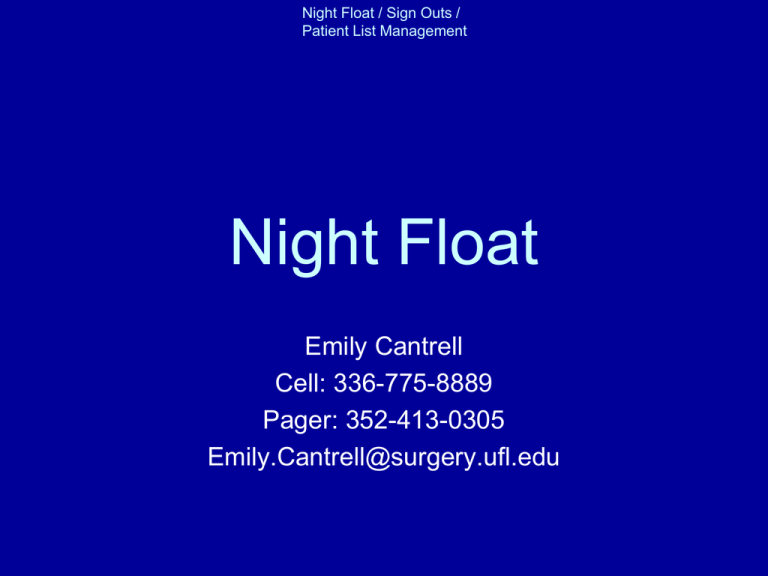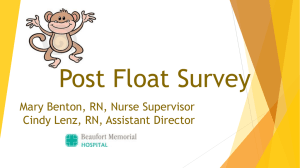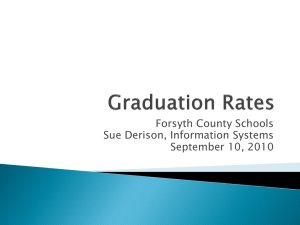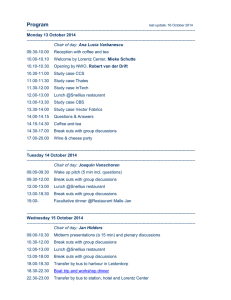Trauma - Residency Home
advertisement

Night Float / Sign Outs / Patient List Management Night Float Emily Cantrell Cell: 336-775-8889 Pager: 352-413-0305 Emily.Cantrell@surgery.ufl.edu Night Float / Sign Outs / Patient List Management The Concept • Night Coverage – South Tower: • PBS, MIS/GI, BMSE, CRS, Transplant, Plastics – North Tower: • Pediatric Surgery • Vascular – Trauma • Trauma Junior covers Burn Surgery at night Night Float / Sign Outs / Patient List Management Who can I call for help? • In house at night: – – – – – Trauma chief (258-9345) Trauma junior (260-8758) Trauma intern (413-3827) Night float (413-0288) CCM (494-9189) • Chief Residents: – – – – – Lindsey Goldstein (353-246-4177) Makesha Miggins (336-971-5252) Joe Campbell (353-281-3180) Trajan Cuellar (352-642-2704) Mike Hong (323-496-5544) • Radiology Reading Room: 44385 Night Float / Sign Outs / Patient List Management The Basics • Active response 6p – 6a – Flexibility in the 6a to 7a hour is essential for transfer of care. • Signout at 6pm or else page service & get signout - It’s all in the details…. (don’t accept “NTD”) Face-to-face signout, senior resident present Help your co-interns with end of day chores Bedside rounding for sick/dynamic patients Get feedback from seniors re: management • Document EVERYTHING in chart and list Night Float / Sign Outs / Patient List Management Sign out • Brief history/presentation – Age, comorbidities, presentation, dx, operation • Notable, relevant changes past 24hrs – Foley, NGT removed, diet, pain meds changed • Active issues (by systems, esp. in ICU) – – – – – – – – – Neuro (bleed, stroke, neuro deficit, delirium/AMS) Pulm (lung dz, pna, PE, secretions) CV (pressors, rhythm issues, BP, baseline CAD) GI (bowel fn status, baseline abd exam) FEN (acid-base, lyte, fluid, nutr’n, renal-UOP) Heme (bleeding issues, plt/inr/ptt, anticoag’d) ID (active infex, recent cx’s, abx – on the list) Drains/tubes/lines: where are those drains? Wound status: open/closed, clean/infected Night Float / Sign Outs / Patient List Management Sign out • Conditional statements (if/then) – Foreseeable issues and plan if they come up • Plan • Special meds (anticoag, abx, atyp pain meds) • Meds to avoid (over-benzo/narcs in elderly) • Allergies -on the list Night Float / Sign Outs / Patient List Management What to do after signout • Postop checks – Time/date note, read the op note – Dx, procedure, SOAP (pain, CP/SOB/N/V UOP, vitals, exam, wound, drains, labs, CXR) • Round-- walk by & check on rest of pts – “eyeball test” (look good, okay, not so good) – Talk to / examine any w potential issues – Get check-boxes done (your ‘to-do’ list) • Respond to calls – If any question of urgency, have nurse repeat new vitals, and go see pt Night Float / Sign Outs / Patient List Management Patient Assessment • Nurse calls – ask for repeat vitals, go see the patient, examine, check wounds, tubes/lines • Types of routine calls • • • • • Pain, nausea, insomnia Fever, AMS Tachycardia, hypoTN Low UOP Critical labs • Assess, make a plan (or call if unsure) & document, document, document • Transfer to higher level of care if needed Night Float / Sign Outs / Patient List Management Workflow • Update the list (be brief / informative) • Update room numbers (Navicare/portal) • After midnight, print list & get it ready – Vitals (trends), I&O, to-do check boxes – For ICU/IMC pts 4-4:30am, update labs – Updates/events to flag for the day team • Bonuses (clean-up the list) – Clean up the list: DVT/GI prophylaxis, Abx, Cx – Help Trauma (if caught-up): alerts, terts, d/c’s • Notes – Pediatric and Vascular Surgery night residents write the notes Night Float / Sign Outs / Patient List Management Other tips • Think for yourself… Nurses will make requests all night long for pain meds, nausea meds, sleep meds…. See every patient and only give those out as necessary. • Do not dismiss a fever or try to mask it w Tylenol • ALWAYS go see patient prior to calling chief. • Notify chief before major decisions: – Transfers, antibiotics, transfusions, vasoactive agents, CT scans Night Float / Sign Outs / Patient List Management Admissions • Hospital to hospital transfers and pre-op admits – Use Navicare, go to 5E (for Gen Surg) or 6E (for Txplt) and look at beds with pending transfers: click on all of them to see which are coming from outside, then look at the attending who accepted (if it’s one of ours, then you’ll be getting called for “orders on your new patient”) – Transfer Center (352-265-0559) • Each patient needs Full H/P and orders in EPIC upon arrival to the ward. • Look thru the OSH paperwork carefully. Take extra care to find and secure Imaging CDs/films. • Call the Service Chief on Call or Fellow on call with questions, to notify them of the patient’s arrival.. • Add the patient to the list. Night Float / Sign Outs / Patient List Management Consults • All general surgery consults at night should go to the Trauma Junior. • Pediatric Surgery and Vascular Surgery night residents will be responsible for seeing consults. Night Float / Sign Outs / Patient List Management Other tips • You might feel like the only person awake in Shands but you are not alone. • CALL YOUR CHIEF. – – – – They want to help They are always available They want to protect you Call with questions but also be thinking of plans Night Float / Sign Outs / Patient List Management Other tips • TRAUMA. • The NF pager is on the trauma list for a reason. If you are not busy, you must be there. – Experience and procedures • Have the junior resident start teaching you how to FAST, put in lines and chest tubes – Just plain “Helping out the team” – Paperwork: • Orders- admit orders, CT orders • H&P • Tertiary (if you’re feeling really generous) Night Float / Sign Outs / Patient List Management Take home points • • • • You are not alone Document everything on chart & list both Transfer to IMC/ICU, get CCM involved Workflow – get postops & check-boxes done so you are ready: for calls, help trauma w alerts, new admits, etc. • Be proactive – check actively on new ops, concerning patients, active/dynamic issues • Be friendly/responsive to nurses Night Float / Sign Outs / Patient List Management Night Float / Sign Outs / Patient List Management Patient Census Management Tad Kim, Vince Mortellaro UF Surgery (c) 682-3793 (p) 413-3222 tad.kim@surgery.ufl.edu Night Float / Sign Outs / Patient List Management Overview • Diagnosis List • Notes (history) section – Initial presentation – Essential information (Abx, Cx, PAB, etc) – Hospital Course • Surgery section • How to use the Name section to your advantage • Take Home Points Night Float / Sign Outs / Patient List Management Diagnosis • For trauma, “Fall” or “MVC” is not a dx • If no injuries & patient had confusion, AMS, GCS, you can use “CHI (Closed head injury)” – Also is a valid code for coding/billing purposes • List all secondary (not PMH) diagnoses and complications (examples on next page). This helps in a number of ways: – Dictations are easier (Prim/2ndary dx are done) – Helps chiefs for M&M Night Float / Sign Outs / Patient List Management Diagnoses – Commonly Missed Acute blood loss Hyper/Hypo-Na anemia Urinary tract infection Atelectasis (IS) Ileus Bacteremia Acid-/Alkalosis DVT/PE Atrial flutter Intestin obstrux – SBO or LBO Malnutrition CHF(D or Sys) Pleural effusion Septic shock Decubitus ulcer – specify site Cellulitis,seroma Aspiration abscess,wd infx GI bleed (site) Urinary retention ARF or AKI Night Float / Sign Outs / Patient List Management Coding Tidbits • Commonly omitted by residents – Atelectasis (if we treat this with incentive spirometry, the hospital can bill for it) – Blood loss anemia (Anemia from blood loss) – Excisional debridement • Type of instrument- scissors, scalpel • Type of tissue- necrotic, skin, fascia, muscle, bone • Approximate depth, size, or weight removed – Septic shock is a much higher DRG compared to “sepsis”. The key is shock – Wound infection Night Float / Sign Outs / Patient List Management Notes section: Initial Presentation • First line – Age, gender, relevant past medical/prior surgeries & presentation – For trauma (TRE): presentation = mechanism, LOC, GCS, FAST, Hct, SBP, (add EtOH/UDS) • Relevant labs & studies on presentation – WBC +/- bands/poly’s, EtOH/UDS (for TRE) – “CT A/P- ..” or “CT hd/Csp/C/A/P/T&L spine” • Interventions or consults (esp for TRE) – i.e. “L CT placed”, “GI Cs (consult) pending” Night Float / Sign Outs / Patient List Management Examples of initial presentation • 56yo M PMH NIDDM/CHF w EF 35%/CRI, prior chol’y ’76, Crohn’s s/p SBR x3 last in ’03 now p/w N/V/abd pn x2d. WBC 14. KUB- AF lvls, dilated SB. CT- SBO. Plan: NPO/NGT/Resus IVF, GI Cs p. (pending) Night Float / Sign Outs / Patient List Management Examples of initial presentation • (TRE) 26yo F PMH ADHD rest driver in MVC RO (rollover) w ejection, +LoC, GCS 14 (-1V), FAST neg, Hct 33, SBP 120, EtOH 200, UDS +cocaine. Pt c/o abd and pelvic pain. CT hd/Csp/C/A/P as above. IRangio/embolization of pelvic bleeder Night Float / Sign Outs / Patient List Management Initial Information, cont’d • Special allergies, i.e. contrast dye & type of reaction – especially if the reaction was anaphylaxis • Special meds (especially anticoagulants) – “PMH Afib on Coum” • Next of kin information when applicable Night Float / Sign Outs / Patient List Management Trauma specific information • • • • • • • • Mechanism (mentioned above) LOC, GCS, FAST, Hct, SBP EtOH & UDS results Which CT scans or XR’s were done DVT scans/date (Radiology section) IVC Filter placement/date (Surg section) List of consults following patient Only injuries (not mechanism) go in the diagnosis slot Night Float / Sign Outs / Patient List Management Additional Information • Antibiotics with start (& stop) date – “Abx: Cpime/Vanc(7/4- )” (include stop date) – Abbreviate so that it’s still recognizable – Include last vanc trough • Cultures – include date – pos results (recent neg results) & usu. don’t include sputum – For Blood, include how many bottles of total – “Cx: 7/2 UCx Ecoli, 7/4 BCx 2of4 MRSA” – Abbreviations: CNS (Coag neg staph), MSSA, MRSA, Cdif, PSA (Pseudomonas Aeruginosa) Night Float / Sign Outs / Patient List Management Additional Information, cont’d • Vancomycin trough w date of last result – “7/3 Vtr 30.5” (put this in Abx section) • Pre-albumin – update on Mon afternoons – include current one w last week’s in ( ) – “PAB 8(10)” Put right before the plan: section • Before PAB, write TF formula/goal rate – This helps when writing transfer orders • A section for “Plan“ at the end after Abx – “Plan: OR w Ortho 7/12, Dispo: Rehab” – Must update constantly to be useful Night Float / Sign Outs / Patient List Management Hospital Course • Create a block in the notes section for the hospital course in chronological fashion between PAB & initial presentation – “7/2 OR. 7/3 txfr to 64, DC NGT/OOB. 7/4 Clears/POM (PO meds). 7/5 Wound opened, W-D BID. 7/6 Fevers -> CT scanIAA (intra-abd abscess), CT-perc drain. 7/8 Reg diet, DC Drain, D/C home.” • If the list is done right, you could perform dictations without flipping thru the chart Night Float / Sign Outs / Patient List Management Surgery section • Reverse chronological order with the surgery type and date in parentheses • Separate different days with semi-colon – “Trach/PEG(7/10); ORIF R femur(7/7); ex-lap, splenect, NJT(7/4) • If the full procedure is listed in the surgery section, no need to repeat in the notes section. Just write “7/7 Ortho OR” in notes Night Float / Sign Outs / Patient List Management Using the Name section • For TRE, “Trauma” goes under last name – Trauma name itself goes after 1st name in ( ) • Use the First name section as a way to alert yourself not to forget certain things: – Prophylaxis (H,N) = heparin, nexium – VAC dressing changes on MWF or TThSat – “iHD (Hemodialysis) on MWF” or “CVVHD” – “Coum”, “Hep gtt”, “Loven” for anticoagulation • This helps you stop these when “pre-opping” the pt – TPN (to remember to write for TPN before 12) – i.e. “Smith, John (VAC MWF) (iHD) (COUM)” Night Float / Sign Outs / Patient List Management Other minor pointers • Use Navicare to: – Find out room assignments fastest – See if there are any unexpected transfers – Status of an OR patient under OR SuiteVue • For consults, list the actual “Date of admission” not the date of the consult • Update resident & student info on the list • Designate a spot on the paper list to be for elements needing computer-list updating Night Float / Sign Outs / Patient List Management Take Home Points • Remember to include: – Prophylaxis, Abx, Cx, PAB, Vanc trough (if pt is on Vanc), Goal tubefeeds – Past medical history, special allergies / meds • Use the first name section as an alert for the need to write TPN, anticoag status, or perform a VAC change • Ideally, any new resident or the night float you’re signing out to should be able to look at the list and know the patient fully Night Float / Sign Outs / Patient List Management Other Professional Duties • • • • • Duty Hours – complete once a week (Tue) HIPAA Training – yearly Compliance (Billing) – yearly Complete delinquent charts on portal Be on time to conferences, M&M, etc. • Case log entry – do these at least at the end of the day, if not right after the case – For the future, each operation, think of: – Op note, orders, dictate, list, case log









